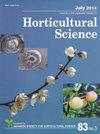Analysis of Floral Scent Compounds and Classification by Scent Quality in Tulip Cultivars
Journal of The Japanese Society for Horticultural Science
Pub Date : 2013-01-01
DOI:10.2503/JJSHS1.82.344
引用次数: 23
Abstract
Floral scents of tulip (Tulipa L.) cultivars are highly diverse, ranging from citrus, honey, or grassy to medicinal. To clarify the diversity of the quality of tulip floral scents, we analyzed the scent compounds of 51 tulip cultivars with characteristic scents. The major scent compounds were five monoterpenoids (eucalyptol, linalool, d-limonene, trans-β-ocimene, and α-pinene), four sesquiterpenoids (caryophyllene, α-farnesene, geranyl acetone, and βionone), six benzenoids (acetophenone, benzaldehyde, benzyl alcohol, 3,5-dimethoxytoluene (DMT), methyl salicylate, and 2-phenylethanol), and five fatty acid derivatives (decanal, 2-hexenal, cis-3-hexenol, cis-3-hexenyl acetate, and octanal). Tulip cultivars were classified into nine groups according to the composition of major scent components and sensory assessment of a living flower: group 1, anise; group 2, citrus; group 3, fruity; group 4, green; group 5, herbal; group 6, herbal-honey; group 7, rosy; group 8, spicy; and group 9, woody.郁金香品种花香成分分析及香味品质分类
郁金香(Tulipa L.)品种的花香非常多样,从柑橘味、蜂蜜味、草味到药用味都有。为了阐明郁金香花香品质的多样性,对51个具有特征香气的郁金香品种的香气成分进行了分析。主要香气化合物为5种单萜类化合物(桉油醇、芳樟醇、d-柠檬烯、反式β-辛烯和α-蒎烯)、4种倍半萜类化合物(石竹烯、α-法尼辛烯、香叶丙酮和β-碘酮)、6种苯类化合物(苯乙酮、苯甲醛、苯甲醇、3,5-二甲氧基甲苯、水杨酸甲酯和2-苯乙醇)和5种脂肪酸衍生物(癸醛、2-己烯醛、顺式-3-己烯醇、顺式-3-己烯乙酸酯和辛醛)。根据主要气味成分的组成和对一朵活花的感官评价,将郁金香品种分为9组:1组,八角;第二组,柑橘;第三组,果味;第4组,绿色;第五组,中草药;第六组,草药蜂蜜;第七组,玫瑰色;第八组,麻辣;第九组,伍迪。
本文章由计算机程序翻译,如有差异,请以英文原文为准。
求助全文
约1分钟内获得全文
求助全文
来源期刊
自引率
0.00%
发文量
0
审稿时长
>36 weeks

 求助内容:
求助内容: 应助结果提醒方式:
应助结果提醒方式:


